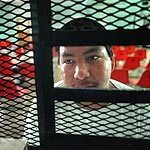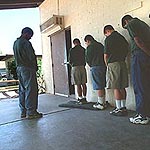The Sacramento Bee
June 28, 1998
|
California ignores its own at out-of-state prison camps By Sam Stanton and Mareva Brown Bee Staff Writers (Published June 28, 1998) There are more than 1,000 of them, California youngsters spread around the country ostensibly for their own good -- and ours. Some live in tepees in the deserts of Nevada and Arizona. Some are housed in girls' dormitories in Colorado that are rigged with alarms. Others, the lucky ones, spend their days on the manicured grounds of a venerable estate in suburban Philadelphia. Every last one of them is a criminal, and every last one of them costs taxpayers an average of $3,600 a month. For this fee, these youngsters are forced to exercise or work or study. Each of these teenagers is subject to rules of physical discipline that, if used in California, could land people in jail. There is virtually no oversight from California over how these programs are run, or how they spend the $45 million each year they get to deal with the state's troubled youngsters, a three-month investigation by The Bee has found.
"These programs are taking advantage of the fact that there's very little oversight, very little regulation," said Loren Warboys, an attorney with the Youth Law Center in San Francisco. "It's really buyer beware. There are good ones and bad ones and there's almost no way to know the difference." With California's group homes besieged by overcrowding and other troubles, private, out-of-state programs have become increasingly critical to the state's juvenile justice system. They are billed as the last stop before the California Youth Authority or CYA, the state's prison for juveniles. But The Bee's review of thousands of pages of documents; visits to 11 youth programs or prisons in California, Arizona and Colorado; and dozens of interviews with investigators, probation officers, program staff members and juvenile offenders has found myriad problems, including: A system that encourages counties to send children hundreds or thousands of miles from home by rewarding the counties financially for doing so. A series of state regulations so lax that California authorities leave the monitoring of these youths to individual probation officers who fit it in as they can, sometimes visiting only every few months. A reliance by California officials on other states to monitor these programs, meaning some can run virtually unchecked and abuses go unreported. "You can't do this type of humiliating punishment in California, that's why you don't see these facilities operating here," said Larry Bolton, chief counsel for the California Department of Social Services. There are countless examples of youths whose futures have been saved by these programs, youths who were considered midlevel offenders and were given a last chance in an out-of-state program rather than be incarcerated inside a CYA prison. "They've got this place all wrong," 18-year-old Luis Mu&150;oz of Holtville said recently in an interview at the main campus of the Arizona Boys Ranch in Queen Creek. "This place prepares you for society. It prepares you with skills you need to have.
"They are good, very good," added Gloria Scott-Powell, a Sacramento woman with a son in the Arizona Boys Ranch, the largest private agency that receives California youth. "Here, he had D's and F's in school, was skipping class. There, he has A's and B's." But since the death of Contreraz four months ago at the Arizona Boys Ranch, state officials have been reviewing California's out-of-state placement program and wondering whether to do away with it. They also have frozen new placements to the Arizona Boys Ranch, although placements are still allowed at 12 other programs in Arizona and elsewhere. Officials from such programs say the Contreraz death is an aberration, an incident that does not represent their philosophies or practices. Yet reviews of documents and interviews indicate that the use of forced exercise or physical restraints is common in some programs. Rite of Passage in Nevada, like Arizona Boys Ranch and others, requires physical exercise. Physical restraint of youths, not allowed in California outside of prison, also is common. In March, for instance, VisionQuest told the Arizona Supreme Court that it would perform a special review any time a youth is restrained more than 15 minutes. "You'd get restrained, sometimes you'd get shoved, sometimes you'd get choked," 21-year-old Orlando Antone, an Oakland veteran of the VisionQuest program who is now serving time in a CYA facility in Stockton, said in an interview. Arizona Boys Ranch and VisionQuest directors say physical force is used only to restrain wards who are endangering themselves or others and that staff members are trained to restrain rather than injure youths.
In a California group home, offenders cannot be restrained or prevented from running away, and cannot be locked inside a room or facility. Outside the state, however, programs allow for such youths to be restrained by one or more staff members and to be pursued if they escape. The irony in the different practices is not lost on many involved in the placing of such youths. "It seems hypocritical to say you can do it out of the state, just don't do it in our presence," said Judge Kenneth G. Peterson, presiding judge of Sacramento's Juvenile Court. "It's like saying we'll fight a war but only through bombings. ... We don't want any hand-to-hand combat, we don't want to see any fighting. But we'll do it from a distance." It is that distance that poses the greatest problem for officials in California. At least 14 teenagers have died in private reform programs since 1980 while serving criminal sentences, according to a list compiled by Cathy Sutton, a self-styled industry watchdog whose 15-year-old daughter, Michelle, died in a private Utah wilderness camp eight years ago. Victims range from an 18-year-old girl from Ripon in San Joaquin County who was killed in a truck accident in 1995 to a boat full of teens who drowned in a sailing mishap in 1980. In one 1984 incident that is hauntingly similar to Contreraz's death, 16-year-old Mario Cano fell seriously ill and collapsed as VisionQuest staff members accused him of faking sickness to get out of a rigorous exercise routine, according to an investigator's report. "When Mario urinated on himself Friday evening (hours before his death), staff interpreted this as "attention-seeking,'" wrote the boy's probation officer, Mike Anderson of San Diego County, in a report to his supervisor that urged the removal of all youths from that program. "So fixed was this belief in Mario's manipulative abilities that a staff member is reported as saying, "Mario is so good, he can change colors,' while Mario was lying unresponsive on the floor." Sutton said that despite the number of deaths, the issue frequently is overlooked because the youths are labeled "troubled." "If you don't care about the kids, maybe you'll care about the money," said Sutton, who has spent thousands of dollars of her own money to lobby legislators, probation officers and the media in her attempt to have some controls placed on out-of-state facilities. No one disputes that the costs to taxpayers are high. For instance, the CYA would charge about $2,210 a month to house a chronic property offender with gang ties but no violent convictions. Out-of-state programs would charge nearly twice as much. What makes the private programs so appealing, though, is a reimbursement system that rewards counties for using out-of-state programs and a newly imposed CYA sliding scale that punishes them for imprisoning nonviolent felons. Counties pay 75 percent to 100 percent of the monthly $2,950 fee for a nonviolent CYA commitment. But the state and federal governments reimburse an average of 55 percent of the cost to send youths to private facilities out of state, dropping the county's cost from about $3,600 per month to around $1,620.
There is an alternative to out-of-state camps, but it is even more expensive for counties than the CYA. Several counties in the state have used their own money to set up programs that mirror those offered out of state. In Colusa County, the Fouts Springs Youth Facility features a strictly regimented program that includes military drills -- but no fences. "It's not necessary to build fences for the same reason the Russians don't build fences in their prisons in Siberia," said Carl Womack, Colusa's chief probation officer, who shares responsibility for the camp with Solano County. But for the majority of counties it is more cost-effective to send youths to out-of-state camps and campuses. However, it is not nearly so cheap to watch over them. Currently, probation officers say the state requires them to visit their wards only twice a year, a requirement so low that most counties say they ignore it and visit much more frequently. "The county is supposed to certify that it's a good and safe place," said Bolton, the state's Department of Social Services counsel. "Placement officers are supposed to be visiting children in care out of California." Visits every month or six weeks are more the norm, but that frequency depends on a variety of things, including the distance and remoteness of the program, the amount of travel money available to a county and the motivation of individual probation officers.
And it also comes down to money. Before October 1996, for instance, Sacramento County probation officer Don Berg used to visit most of his wards every month. But budget cuts eventually caught up to that schedule and reduced it to every six weeks. For Glen Mills Schools, a Pennsylvania program considered one of the nation's finest, visits from Sacramento come four times a year, with the program paying the cost of the air fare to the East Coast twice annually. Since Contreraz's death, however, visits to Sacramento youths at Arizona Boys Ranch have increased to every seven to 10 days. The youth-program industry does not question the need for regular visits, particularly given the nature and history of out-of-state programs. Many operate in extremely remote areas, where it is difficult for youths to escape, giving them a chance to focus on the program rather than outside distractions. To flee the Arizona Boys Ranch orientation facility near Oracle, for instance, youths would have to walk five miles over the hilly backside of Mount Lemmon, just north of Tucson. When they reach pavement, they still are more than 50 miles from a town of any size, conspicuous on the high desert. To get away from Rite of Passage in Nevada, youths would have to cross miles of the high desert on an American Indian reservation. "Most of these kids don't know where they are," said Berg, who oversees youths at the Arizona Boys Ranch and Rite of Passage. "It's sad, but I'll take the kids to ROP and deliver them -- we're talking some hard-core gang-banging thugs -- and I'll look over at them and they'll just have tears streaming down their cheeks. They had no idea that a place could be so remote." But others question placing these youths in remote areas and turning them over to staff members who control their lives so completely that they can even tell them when and where to go to the bathroom. "The problem with these real remote things is if they're not monitored closely and the staff they get is not monitored closely, that's when you get into trouble," said Woods, the San Francisco social worker. That is precisely what happened in the Contreraz death, according to investigators and Arizona Boys Ranch officials who say staff members at the Oracle camp repeatedly broke ranch rules in their treatment of the boy.
Critics of that proposal say it won't work for a simple reason: In most counties, placement in the CYA is the only other choice. "I'm sure the Youth Authority has a number of success stories, but I haven't experienced them. It's basically state prison for kids. The kids enjoy being able to kick it with their peers. They get gang tattoos. They hang out. It's a place to kill time," Berg said. A state task force is seeking solutions, as is the National Counsel on Crime and Delinquency, a nonprofit child advocacy group which has been asked to study the issue by legislators. Meanwhile, Sen. Richard Polanco, D-Los Angeles, has pushed for a bill backed by the Arizona Boys Ranch that would relax regulations to allow Boys Ranch and similar programs to operate in California. But some advocates say the entire juvenile justice system needs to be scrapped and rebuilt. "Whatever California's doing ain't working," said Jack Jacqua, co-founder of the Omega Boys Club in San Francisco and a longtime social activist and youth expert.
"We're building jails, we're building prisons for young people. ... If we can't do better than that, if we can't find some liberating, innovative, visionary programs for young people, then we might as well ship them to Europe and Asia and Mars."
|
| ||||||||||||||||
� 1996-8
[email protected]






 Who's guarding the kids?
Who's guarding the kids?

